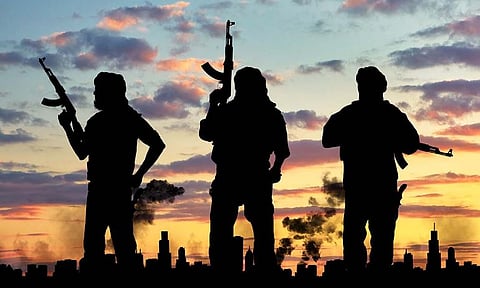
- Home
- Live Blog
- Breaking News
- Top Headlines
- Cities
- NE News
- Sentinel Media
- Sports
- Education
- Jobs

RANA BANERJI
Terrorism can be defined as acts of destruction of people or property resorted to by individuals or a group of people, not acting on behalf of an established government but wanting to redress real or imaginary injustices attributed to the State. Though ideological and material motivations of terrorism can be seen to be global, they have impacted after 9/11, and more recently, after the spread of Islamic States (IS) ideology, in certain specific local & regional conditions.
Conventional root causes contributing to growth of terrorism included unemployment, poverty, growing disenchantment with feudal structures and an abysmal failure of grievance redressal mechanisms to deliver justice. A changing perception of Islamic history led to the growing attractiveness of the Pan Islamic idea, consequent belief in recreation of a Caliphate or ‘oneness of the Ummah’, where better delivery of justice, even by rough and ready methods of local Shariah courts, could be an option. Wahabi/Salafi and Ahle Hadis Islamic tenets influenced traditional Deobandi/ Barelvi/ Sufi variants of Islam. The concept of ‘jehad’ underwent a change.
Traditional interpretations of Jehad relied on the Arabic word ‘Jahad’, which means fighting against unbelievers and striving to advance divine causes. War was justified only if authorized by the Ruler and could only be used against external enemies. Under new interpretations, Islamophobes treat Jehad as a purely military concept, where ‘Bellum Justum’ stands for justifiable violence instead of violence in self-defence. This makes combating injustice through violence and use of violence against civilians justifiable.
This newer interpretation of Islam seemed to be founded on a visceral hated of the West, and more specifically, the United States and Israel.
The globalization of jihadi terrorism can be traced to the formation of the International Islamic Front (IIF) by Osama bin Laden in February, 1998. It was initialled at first by five signatories, at least two of whom, Fazlur Rehman Khalil of the Harkat ul Mujahideen (HuM – later Harkat ul jihad e Islami-HUJI) and Mir Hamza, of the Ulema Society were Pakistani. Very soon thereafter, two other Pakistani radical outfits, Lashkar-e-Toiba (LeT) and Sipah-e-Sahaba (SSP) joined it (May, 1998). The Jamiat-e-Ulema-i-Pakistan (JuP) also became a signatory.
Repressive regimes in the region often used Islam to justify illegal usurpation of power and subvert democratic processes and institutions. In the process, they invested disproportionate clout to street power of Islamists to serve vested interests. This led, in time, to State sponsorship of terror, with use of non-State actors as asymmetric force multipliers becoming justifiable, to serve perceived geo-strategic objectives.
Abbottabad struck Al Qaeda’s death knell in May, 2011. Ayman Zawahiri was not charismatic enough. On the run now and believed to be in Iran, he recently went public on his spat with the Pakistani military establishment. Hamza bin Laden’s reported death is a further setback.
In this backdrop, the impact of Baghdadi’s spectacular rise and gain of territory in Iraq offered a new type of attraction for radicalized Muslim youth in the sub-continent. Islamic State (IS) started attracting adherents, especially among youth. A Caliphate – synchronous with territory but also capable of providing a vehicle for salvation of all Muslims through allegiance or ‘bayaa’ by Muslims and ‘non-Muslims’ was possible on fee payment, though no ‘surrenders’ were admissible as ‘return’ – ‘returnees’ or ‘drop outs’ was deemed not possible for ‘soldiers of Islam’. Daesh philosophy had several other interesting features – it rejected peace, it denied any recognition of borders between nation states; it stressed that genocide was acceptable as a recognized means used under medieval, traditional Islamic methods of war – beheadings, slavery, crucifixion were justified and valid; belief in ‘takfir’ reflected Salafist influence on IS. Belief in Apocalypse – a harbinger of the end of the world – with the idea of the Mahdi leading Muslims to victory (or to death) against the ‘anti-Messiah’ in Jerusalem, also had an almost fatal lure for disillusioned youth, not only in advanced western civil society.
IS was anti-US but there seemed to be no obsession to resort to extra-territorial terror action. This was its major difference from Al Qaeda. The appeal of ‘Apocalypse’ was different from Al Qaeda’s unmitigated hostility to the West.
As IS retreated in defeat from Iraq and Syria, its tactics underwent a change. Their leadership, which is on the run, has fallen back on increasing use of franchisees to remain relevant. In new terror incidents, local groups act first, IS owns up to those actions later. IS strategy would look for new conflict areas, build up alliances with existing militant organizations, eg., Tehrik-e-Taliban factions in Pakistan (TTP), TTP (Khorasan group) in Aachin district of Nangarhar, Afghanistan, disgruntled anti-Buddhist Muslims in Sri Lanka etc.
Complex socio-cultural milieu and political developments in different countries of the sub-continent will continue to provide fertile ground for terror and violence, where disgruntlement of disenfranchised classes and intensely felt perceptions about persisting injustices in the system, like the belief in ‘azadi’ among younger ‘radicals’ in South Kashmir and India’s seeming inability to counter this resentment effectively. To counter these trends, a holistic outreach may be needed to impact on the minds of potential converts to terrorism. Specific country approaches to assess future terrorist threats would no doubt have relevance, though these may have to be premised, and pursued on different calculations. (IANS)